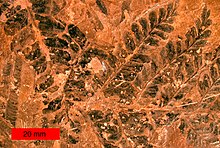Medullosales
| Medullosales Temporal range: Carboniferous–Permian |
|
|---|---|
 |
|
| Neuropteris ovata Hoffmann, Late Carboniferous of northeastern Ohio. | |
| Scientific classification | |
| Kingdom: | Plantae |
| Division: | †Pteridospermatophyta |
| Order: | †Medullosales |
| Families | |
The Medullosales is an order of pteridospermous seed plants characterised by large ovules with circular cross-section, with a vascularised nucellus, complex pollen-organs, stems and rachides with a dissected stele, and frond-like leaves. Their nearest still-living relatives are the cycads.
Most medullosaleans were small to medium-sized trees. The largest were probably the trees with Alethopteris fronds - these fronds could be at least 7 metres long and the trees were perhaps up to 10 metres tall. Especially in Moscovian times, many medullosaleans were rather smaller trees with fronds only about 2 metres long, and apparently growing in dense, mutually supporting stands. During Kasimovian and Gzhelian times there were also non-arboreal forms with smaller fronds (e.g. Odontopteris) that were probably scrambling or possibly climbing plants.
Ovules in different medullosalean species could vary from maybe 1 cm to over 10 cm long - the latter being the largest known ovules produced by any non-angiosperm seed-plant. It was traditionally believed that the ovules were borne directly on the fronds, replacing one of the pinnules on the ultimate pinnae. However, there is a strong possibility that this reconstruction was based on the chance finds of ovules having been preserved just lying on a piece of pinna rather than in organic attachment to it. A number of cases are now coming to light that suggest that the seeds were borne in clusters on relatively slender, branching axes, and that these trusses of ovules would have been produced from the top of the trunk among the crown of fronds.
The seed megaspore was surrounded by two layers of tissue: a vascularised nucellus and a usually three-layered integument; the nucellus and integument were completely free except at the base of the ovule. There has been some debate as to the exact homologies of these tissues, and it has been argued that the vascularised nucellus was in fact the nucellus and integument that have become fused together, and that the 'integument' was homologous to a cupule that contained only one ovule.
Most medullosalean ovules preserved as casts or adpressions show three longitudinal ribs and are assigned to the fossil genus Trigonocarpus. When such ovules are preserved as petrifactions, they are assigned to the fossil genera Pachytesta or Stephanospermum, depending mainly on differences in the apical form of the ovule. Another group of medullosalean seeds, usually associated with parispermacean fronds (see later), have six longitudinal ribs and are referred to as Hexagonocarpus when found as adpressions or casts, and Hexapterospermum when found as petrifactions.
...
Wikipedia
